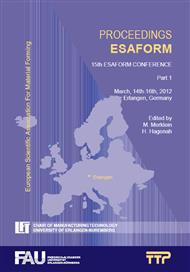p.3
p.17
p.23
p.29
p.35
p.41
p.47
p.53
Determination of Forming Limit Strains Using Marciniak-Kuczynski Tests and Automated Digital Image Correlation Procedures
Abstract:
Forming limit strains are used to construct a forming limit diagram (FLD), which is a diagram in the principal strain space, traditionally used for designing forming operations of sheet metals. A line indicating the boundary between safe and unsafe strains is often called the forming limit curve (FLC). FLDs are also used to evaluate results from finite element simulations. Therefore consistency and reproducibility are important. This paper deals with the experimental determination of forming limit strains from Marciniak-Kuczynski (MK) tests. The material tested is AA6016 aluminum alloy in three different conditions: virgin material and material subjected to 5% and 8% deformation by rolling. Strains were measured by the use of digital image correlation (DIC) technique. Forming limit strains were determined by the use of two automated methods. The results from the two methods are compared and evaluated regarding their applicability to the Marciniak-Kuczynski test and ability to capture actual forming limit strains.
Info:
Periodical:
Pages:
17-22
Citation:
Online since:
February 2012
Authors:
Price:
Сopyright:
© 2012 Trans Tech Publications Ltd. All Rights Reserved
Share:
Citation:


